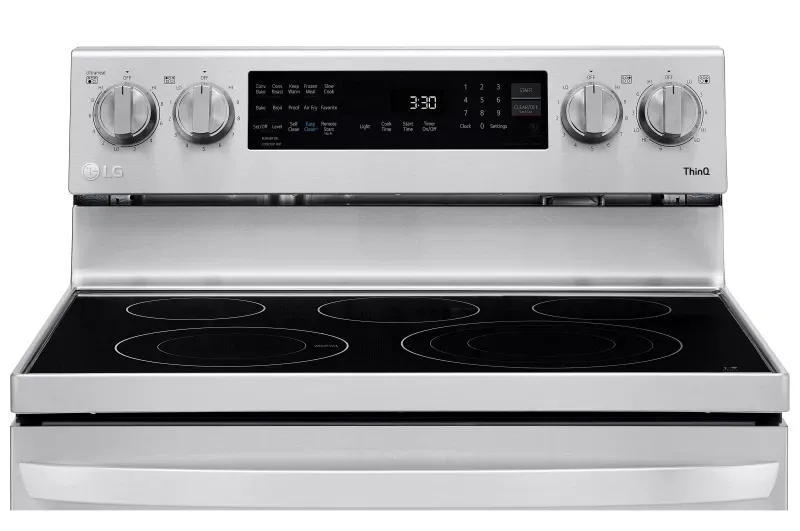How to Clean Stove Burners: A Manual for Cleaner, Safer Cooking

Maintaining clean stove burners is essential for a well-functioning and safe kitchen. Dirty burners not only detract from the overall appearance of your stove but can also lead to uneven cooking, unpleasant odors, and even potential fire hazards. Regular cleaning prevents food residue and grease buildup, ensuring your stove operates efficiently and safely.
In this guide, we'll explore various methods for cleaning different types of stove burners, including gas, electric, and glass stove tops. Whether you're dealing with minor spills or tough, baked-on grime, we'll provide you with practical, easy-to-follow steps using common household items like baking soda and vinegar. By the end of this article, you'll have all the tips and tricks you need to keep your stove burners sparkling clean and in top working condition.
Preparing for Cleaning Your Stove Burners
Safety First
Before you begin cleaning your stove burners, safety should be your top priority. Ensure that your stove is completely turned off and the burners are cool to the touch. This step is crucial to avoid burns or other injuries while cleaning. If you have an electric stove, unplug it to prevent any electrical accidents. Taking these precautions will help you clean safely and effectively.
Gathering Materials
To make the cleaning process smooth and efficient, gather all the necessary materials beforehand. You will need the following items:
- Baking Soda: Excellent for making a cleaning paste to tackle tough stains.
- Dish Soap: Useful for cutting through grease and grime.
- Vinegar: A natural cleaner that helps dissolve stubborn residue.
- Non-Abrasive Scrub Pads: Prevent scratching the surface of your stove while scrubbing.
- Toothbrush: Perfect for cleaning small, hard-to-reach areas.
- Microfiber Cloth: Ideal for wiping down and polishing your stove parts.
- Optional Ammonia: For deep cleaning particularly stubborn or baked-on grime.
By preparing these materials in advance, you ensure that the cleaning process is straightforward and efficient. With everything at hand, you’re ready to dive into the detailed cleaning steps for each type of burner, ensuring your stove remains in top-notch condition.
Cleaning Gas Stove Burners: A Step-by-Step Guide
Removing Grates and Burner Caps
To start, make sure your stove is completely off and cool. Begin by carefully removing the grates and burner caps. Lift the grates gently to avoid scratching the stovetop surface, especially if you have a stainless steel stove. For the burner caps, simply lift them off the burner heads. If they are stuck due to grime buildup, wiggle them slightly while lifting to loosen them without forcing.
Soaking Components
Once you've removed the grates and caps, it's time to soak them. Fill your sink or a large basin with hot, soapy water. Submerge the grates and caps in the water and let them soak for at least 20 minutes. This soak helps to loosen any hardened food residue or grease, making the next steps much easier.
Scrubbing with Baking Soda Paste
While the grates and caps are soaking, prepare a baking soda paste. Mix equal parts of baking soda and water to form a thick paste. After the soaking period, remove the grates and caps from the soapy water and apply the baking soda paste to any stubborn stains. Use a non-abrasive scrub pad or an old toothbrush to scrub the surfaces. The mild abrasive action of the baking soda will help lift off the grime without damaging the components.
Rinsing and Drying
After scrubbing, rinse the grates and caps thoroughly with warm water to remove all soap and baking soda residue. Dry them completely with a microfiber cloth to prevent any water spots or rusting. Make sure they are entirely dry before reassembling them on the stove to ensure proper function and safety.
Reassembling Burners
Once all components are clean and dry, reassemble the burners. Place the burner caps back on the burner heads, ensuring they are seated correctly. Reposition the grates on the stove top, making sure they are aligned properly and stable. Finally, turn on each burner briefly to check that they ignite properly and burn evenly, indicating correct reassembly.
By following these detailed steps, you'll keep your gas stove burners clean and in optimal working condition, ensuring efficient cooking and maintaining a spotless kitchen.
Cleaning Electric Stove Burners: Types of Electric Burners
Electric stoves typically come with either coil burners or smooth-top burners, each requiring a slightly different cleaning approach. Coil burners consist of exposed heating elements that can be detached, while smooth-top burners have a flat, ceramic or glass surface with embedded heating elements. Understanding these differences is crucial for effective and safe cleaning.
Removing Burner Coils
For coil burners, start by ensuring the stove is off and the coils are completely cool. Gently lift each coil out of its socket; this usually involves a slight tug-and-lift motion. Be cautious not to damage the connection points. If you're unsure how to remove the coils, refer to your stove's manual for specific instructions.
Soaking and Scrubbing
Place the removed coils aside and focus on cleaning the drip pans and the stovetop surface. Fill a sink or large basin with hot, soapy water and soak the drip pans for about 20 minutes. For tough stains on the coils and drip pans, make a paste using baking soda and water. Apply the paste to the stubborn spots and let it sit for 15-20 minutes before scrubbing with a non-abrasive pad or an old toothbrush. For the smooth-top burners, use a mixture of vinegar and water or a specialized stovetop cleaner to wipe down the surface gently.
Rinsing and Reassembling
After scrubbing, thoroughly rinse the coils, drip pans, and any other removable parts with warm water. Ensure all soap and baking soda residue is washed away. Dry each component completely with a microfiber cloth to prevent water spots and potential rust. Once dry, reattach the coils to their sockets, ensuring a secure fit. For smooth-top burners, polish the surface with a clean, dry cloth to restore its shine.
By following these steps, you can maintain the cleanliness and efficiency of your electric stove burners, whether they are coil or smooth-top. Regular maintenance not only keeps your kitchen looking pristine but also ensures your stove operates safely and efficiently.
Cleaning Glass Stove Tops
Cooling Down and Wiping
Before starting the cleaning process, ensure that your glass stove top is completely cool. Attempting to clean a hot surface can cause burns and may also result in streaks and smudges. Begin by wiping the surface with a damp cloth to remove loose debris. Next, use a mixture of warm water and a few drops of dish soap to create a mild cleaning solution. Dampen a sponge or cloth in the soapy water and gently clean the entire glass surface. This initial cleaning helps remove light grease and grime, making it easier to tackle tougher stains later.
Using Vinegar for Tough Stains
For stubborn stains and burned-on residue, vinegar is an excellent natural cleaner. Spray white vinegar directly onto the stained areas and let it sit for about 10-15 minutes. The acidity of the vinegar helps to break down the grime, making it easier to wipe away. After the vinegar has had time to work, use a non-abrasive sponge to scrub the stains gently. For extremely tough spots, you can combine the vinegar with baking soda to form a paste, apply it to the stains, and scrub gently after letting it sit for a few minutes.
Polishing with Glass Cleaner
Once the tough stains are removed, it's time to polish the glass surface to achieve a streak-free shine. Use a commercial glass cleaner or make your own by mixing equal parts of water and vinegar. Spray the cleaner onto the glass stove top and wipe it down with a microfiber cloth in circular motions. This final step not only enhances the appearance of your stove but also helps to remove any remaining residue, ensuring your glass top looks pristine and gleaming.
By following these detailed steps, you can keep your glass stove top in excellent condition, making your kitchen look spotless and well-maintained. Regular cleaning and polishing will not only preserve the aesthetic appeal of your stove but also ensure it functions efficiently.
Maintenance Tips for Stove Burners
Having A Regular Cleaning Routine
Establishing a regular cleaning routine is essential for keeping your stove burners in top condition and preventing the buildup of grease and grime. Here are some tips for maintaining a clean stove:
- Daily Cleaning: After each use, wipe down the stovetop with a damp cloth to remove any spills or splatters. This quick action helps prevent food and grease from hardening and becoming more difficult to clean later.
- Weekly Cleaning: Once a week, give your stove a more thorough cleaning. Remove burner grates and caps (if applicable) and soak them in warm, soapy water. Clean the stovetop with a mild cleaner or a mixture of vinegar and water, and scrub away any accumulated grime. Regular weekly cleaning ensures that dirt and grease do not build up over time, making the cleaning process easier and more effective.
Using Burner Covers
Burner covers are an excellent addition to your kitchen cleaning arsenal. Here are the benefits of using burner covers:
- Protection: Burner covers shield the burners and surrounding areas from spills and splatters, reducing the amount of cleaning required.
- Ease of Cleaning: Covers can be easily removed and cleaned, preventing spills from reaching the burners and making the cleanup process faster and more convenient.
- Aesthetic Appeal: Burner covers can also enhance the appearance of your stove, keeping it looking clean and tidy even when not in use.
Professional Maintenance
While regular cleaning can handle most of the maintenance tasks, there are times when professional cleaning and maintenance services are necessary:
- Deep Cleaning: If your stove burners have significant buildup that regular cleaning cannot address, a professional cleaning service can provide a deep clean, restoring your stove to its optimal condition
- Repairs and Adjustments: If you notice issues such as uneven heating, strange odors, or malfunctioning burners, it's advisable to contact a professional. They can diagnose and repair any problems, ensuring your stove operates safely and efficiently.
- Annual Maintenance: Consider scheduling professional maintenance at least once a year. Technicians can inspect your stove for any potential issues, clean hard-to-reach areas, and ensure everything is functioning correctly.
By incorporating these maintenance tips into your routine, you can keep your stove burners in excellent condition, ensuring they perform well and last longer. Regular care and occasional professional maintenance will help you maintain a clean, efficient, and safe kitchen environment.
A Clean Range Means Better Cooking
Maintaining clean stove burners, just like with any other of your home appliances, is crucial for both the functionality and safety of your kitchen. By following the detailed steps outlined in this guide, you can effectively clean gas, electric, and glass stove tops, ensuring they remain in optimal condition. Regular cleaning routines, such as daily wipe-downs and weekly deep cleans, help prevent the buildup of grease and grime, making the cleaning process easier and more manageable over time.
Incorporating these cleaning habits into your regular kitchen maintenance will not only keep your stove looking spotless but also ensure it operates efficiently and safely. Don't forget the benefits of using burner covers and the importance of professional maintenance when needed. By taking these proactive steps, you can enjoy a cleaner, safer, and more efficient cooking environment.
So, roll up your sleeves and give your stove the care it deserves. With consistent effort and the right techniques, you'll keep your kitchen shining and your stove burners performing at their best. Happy cleaning!
